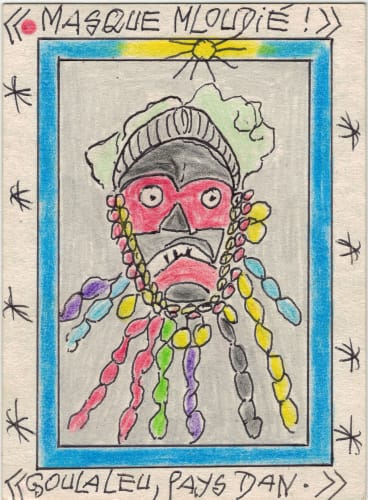Bouabré was among the first Ivorians to be formally educated by the French colonial government. In 1948 he had a vision he described as “the heavens opened up before my eyes and seven colorful suns described a circle of beauty around their Mother-Sun, I became Cheik Nadro: ‘He who does not forget.’" This vision directly influenced much of his later work. He created hundreds of drawings on cardstock while working as a clerk in various government offices, and these drawings as a whole comprise a project titled World Knowledge—an encyclopedia of universal knowledge and experience. Bouabré also created a 448-letter, universal Bété syllabary, which he used to transcribe the oral tradition of his people, the Bétés. This visual language is recorded through a set of approximately 1,000 small cards, each bearing monosyllabic pictograms, symbolic imagery, and text, with Bouabré’s commentary on life and history.
His work was featured in the 1989 exhibition Magiciens de la Terre at the Centre Georges Pompidou and the Grande Halle at the Parc de la Villette in Paris. He was invited to participate in the Documenta 11 (2002), curated by Okwui Enwezor, with his work ‘Alphabete Bété (1991/92), that comprises the alphabet that Bouabré invented for the Bété language. His work was featured both in the Ivory Coast Pavilion at the 55th Venice Biennale, and in the main exhibition “The Encyclopedic Palace,” curated by Massimiliano Gioni (2013) and at the Cantor Arts Center at Stanford University during his solo exhibition “Alphabété: The World Through the Eyes of Frédéric Bruly Bouabré” (2019).
In 2014, Bouabré passed away at the age of 91 in Abidjan, Ivory Coast.

